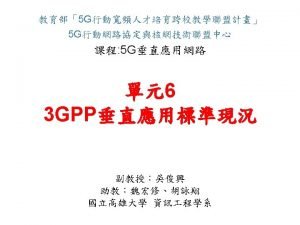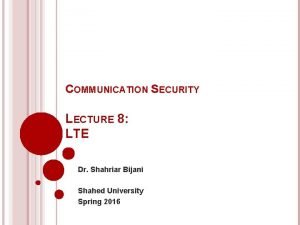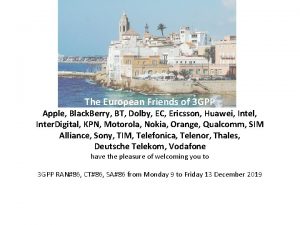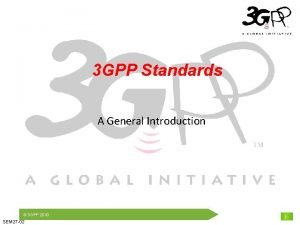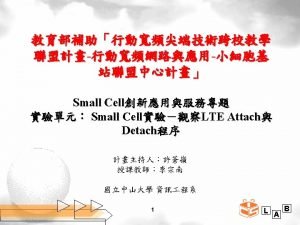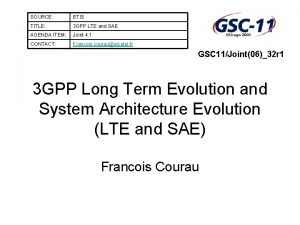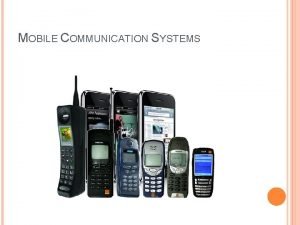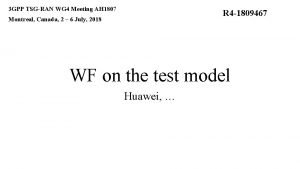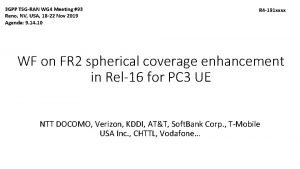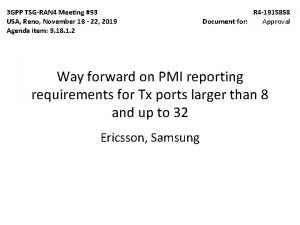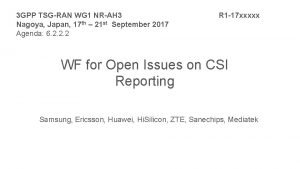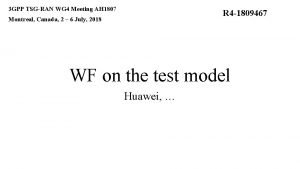3 GPP TSGRAN WG 4 96 e 17









- Slides: 9

3 GPP TSG-RAN WG 4 #96 e 17 th Aug - 28 th Aug. 2020 R 4 -2012607 WF on NR-U BS Tx and Rx remaining requirements for NRU ZTE, … 1

Background • In RAN 4#96 e, open issues are identified for NR-U BS requirements which needs further discussion, open issues are listed as following: 1) How to reflect NR-U BS to support AAS BS type; 2) IBB/OOBB requirements for NR-U BS; 3) Δf. OBUE and Δf. OOBB for NR-U BS type 1 -C and 1 -H; 4) Frequency offset of interferer signal for RX ACS and IMD requirements; 5) LO leakage exception for NR-U BS Tx Note : 1) and 4) has been resolved in the GTW meeting with following agreement: Proposal 1: Prated, C, AC used in WF [4] and CR [3] should be updated as Prated, x; Proposal 1: to use the following frequency offset for ACS interfering signal in Table 7. 4. 1. 2 -2 a in R 42010960; Proposal 4: to use the following frequency offset for RX IMD interfering signal in Table 7. 7. 2 -2 a in R 42010960; Reference: [1]R 4 -2010738, CR to TS 38. 104: Introduction of NR-U into BS core specification, Nokia [2]R 4 -2010743, Discussion on BS core specification drafting , Nokia [3]R 4 -2010959, NR-U BS Tx requirements, ZTE Corporation [4]R 4 -2010960, NR-U BS Rx ACS, IBB, OOBB, IMD requirements, ZTE Corporation [5]R 4 -2010495 [6] R 4 -1902505, WF on NR-U BS RF requirements, Nokia Shanghai Bell 2

Background As a reminder in-band out-of-band boundary was discussed some time ago in RAN 4 when AAS and NR was introducing and agreed in [1]. Main motivation to introduce wider boundary was that for antenna arrays in which antenna and radio are closely integrated and there a potentially large number of transmitters, the amount of space for integrating filters is limited. It should be noted that time boundary was discussed for all bands except Band 46. Also that time there was no NR-U. From [1]: [1] R 4 -1711779, WF on in-band out-of-band boundary, NTT DOCOMO, INC. , Nokia, Ericsson, Huawei, ZTE 3

WF for Δf. OBUE and Δf. OOBB For NR-U BS type 1 -C for n 46 NR-BS Type 1 -C Δf. OBUE Δf. OOBB Supporting companies Option 1 (legacy LTE/LAA values) 10 MHz 20 MHz ZTE, Huawei Option 2 (legacy NR values) [40 MHz ] [60 MHz] Huawei, Nokia, Ericsson Δf. OBUE Δf. OOBB Supporting companies Option 1 (legacy LTE/LAA values) 10 MHz 20 MHz Option 2 (legacy NR values) 40 MHz 60 MHz Agreement: option 2 with [ ]. For NR-U BS type 1 -H for n 46 : ZTE, Huawei, Nokia, Ericsson Agreement: option 2 4

WF for Δf. OBUE and Δf. OOBB For NR-U BS type 1 -C/1 -H for n 96 NR-BS Type 1 -C/1 -H Δf. OBUE Δf. OOBB Supporting companies Option 1: 40 MHz 60 MHz Nokia, E///, Qualcomm, AT&T Option 2: Further evaluation and analysis required with the associated assumption with band plan, channel arrangements ZTE, Huawei, CMCC, China Telecomm, MTK Option 3: Take the values in option 1 for band n 96 with a note in the specification “ if new band(s) with same frequency ranges as n 96 introduced in the future, the values can be further evaluated and updated if needed for such new band(s)” (Nokia, E///, Qualcomm, AT&T) Session Chair: No majority view seen based on the views collected from this GTW session. Session chair recommend to further discuss in main session GTW session if time allowed to treat sys parameter, BS RF and UE RF as a package. 5

IBB and OOBB requirements For NR-U BS type 1 -C and 1 -H for n 46: NR-BS Type 1 -C General blocking requirement Supporting companies Option 1 To reuse LTE/LAA requirement ZTE, Huawei Option 2 To reuse NR requirement Nokia, E///, QC Follow previous agreement in R 4 -1902505 proposal 6 (option 2). NR-BS Type 1 -H General blocking requirement Supporting companies Option 1 To reuse LTE/LAA requirement ZTE Option 2 To reuse NR requirement Nokia, Huawei, E/// Agreement: Option 2 Note: for background for e. LAA BS RX requirement could be found in the following R 4 -167192, R 4 -166293. 6

IBB and OOBB requirements For NR-U BS type 1 -C and 1 -H for n 96: NR-BS Type 1 -C/1 H General blocking requirement Supporting companies Option 1 To reuse NR requirement Nokia, E///, QC Option 2: Further evaluation and analysis required with the associated assumption with band plan, channel arrangements ZTE, Huawei Tentative Agreement: Agree with option 1 with [ ]. Object by : Huawei and ZTE as they need time to further check and analyze. Session chair: We see majority based on the views collected in GTW session. Companies still keep consistent objection to go with majority option. Suggest to further treat in main session. Note: for background for e. LAA BS RX requirement could be found in the following R 4 -167192, R 4 -166293. 7

LO leakage for NR-U punctured channels (applied for both 5 GHz and 6 GHz) An exception to the spectrum emission requirements for the non-transmitted 20 MHz channels allows a single 2 MHz bandwidth to extend to Prated, x-28 d. B , or -20 d. Bm, whichever is the greatest. Option 1: to define LO leakage exception • Nokia Option 2: not to define LO leakage exception • ZTE, Huawei Tentative Agreement:Option 2 Nokia : Object this tentative agreements. Session chair: We see majority based on the views collected in GTW session. Company still keep consistent objection to go with majority option. Suggest to further treat in main session. Note : To define LO leakage exception will degrade the UE performance Note: LO leakage exception is defined also in UE specification. 8

Additional band n 96 aspects • To ddefine Local Are BS at RAN 4#96 e meeting and study further MR BS in the coming meeting. • The the following NF will be used to derive Rx requirements: • 11 d. B for Medium Range BS • 14 d. B for Local Area BS • The Receiver requirements need to be updated following above agreements • For co-existence and co-location Tx requirements , keep the requirements with [ ], which can be further discussed and updated if needed 9


